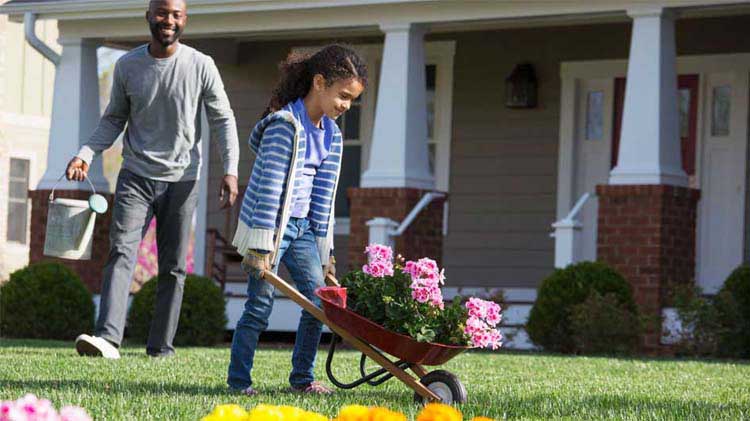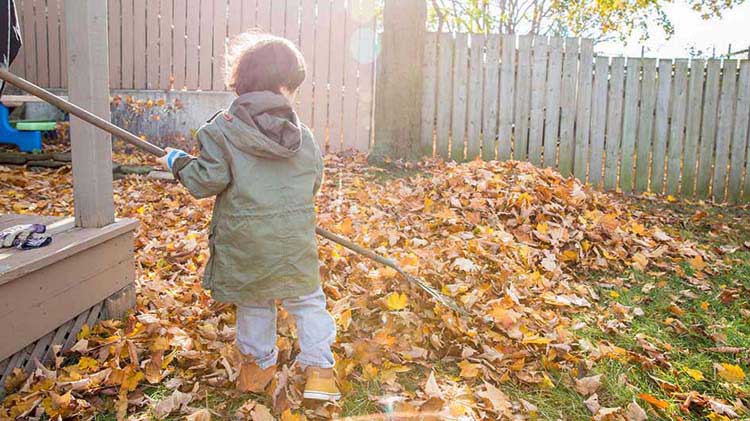Spring into action with yard cleanup
Precautions and safety tips for spring yard work.
Spring yard work safety tips
Blue skies, chirping birds, warming temperatures — April is prime time for getting home exteriors, yards and gardens back into shape. A home maintenance routine can help your house operate more efficiently. Before you get started on your outdoor to-do list, consider these lawn care safety precautions.
Dress for yard cleaning
- Wear protective footwear. Wear shoes or boots, not sandals, to protect your toes.
- Wear properly fitting gloves. This improves your grip on tools and also helps keep skin safe from blisters, sunburn, bug bites, poisonous plants and chemicals.
- Wear hearing protection when using loud equipment.
- Wear safety glasses to keep flying objects out of your eyes.
- Apply bug spray to keep pests away. Shower after use to remove the chemicals from your skin. And while you're at it, take a minute to look for ticks. If you find one, gently pull it out with tweezers.
- Apply sunscreen or skin products with SPF to any exposed skin to help prevent sunburn. Don't be fooled by cloudy days; you can still get a sunburn.
Work smart
- Stretch your body. Take time to stretch and warm up before the work begins. Weeding, trimming and raking are repetitive motions — change your posture or stance every few minutes and switch activities every 30 minutes.
- Lift things carefully and safely. Lift properly by bending at the knees and hips and using leg power rather than bending at the waist and putting the strain on your back. Instead of carrying heavy or unwieldy loads, employ a cart or wheelbarrow.
- Drink water and take breaks in the shade. Even if it's not hot or humid, yard work is exercise, and staying hydrated is important to avoid heat related illness.
- Don't use power tools under the influence. The same rules that apply to vehicles apply to power tools, including lawn mowers. Say no to distractions and anything that might cloud judgment.
- Use caution if operating gas-powered equipment or tools. To help prevent carbon monoxide buildup and breathing in harmful chemicals, do not use this type of equipment in an enclosed space. See that the space you are working in is well ventilated with fresh air.
Ready the tools
- Inspect equipment. Check for and replace any damaged parts.
- Familiarize yourself with power tools and how they work. Read owner's manuals (many are available online) and know about various switches, modes and required maintenance.
- Check cords on tools and extension cords. Look for cuts, cracks and frayed wires and do not use them if damaged. Also check the label to make sure you don't use an indoor extension cord outside.
- Make sure tools are in the "off" position before plugging them in or unplugging.
- Use ladders safely. Set ladders on a firm, level surface; do not stand on any of the top three rungs; and use a utility belt to hold tools so you can properly climb facing the ladder.
- Call 811 before you dig. This notifies local utilities to check your property before you plant a tree, dig a trench or set fence posts.
Protect loved ones
- Watch out for children and pets. See that children and pets are inside (or well supervised if out) while you work.
- Securely store tools and equipment. Store sharp tools, weed killer, fertilizer and other dangerous items in a locked cabinet out of reach of curious hands and mouths.
- Educate and supervise kids with equipment. Before allowing any child to operate a mower, sound judgment, strength, coordination and maturity are necessary. Healthychildren.org from the American Academy of Pediatrics, recommends that children should have these characteristics and be at least 12 years old before operating any type of mower — and at least 16 years old to operate a riding mower.




